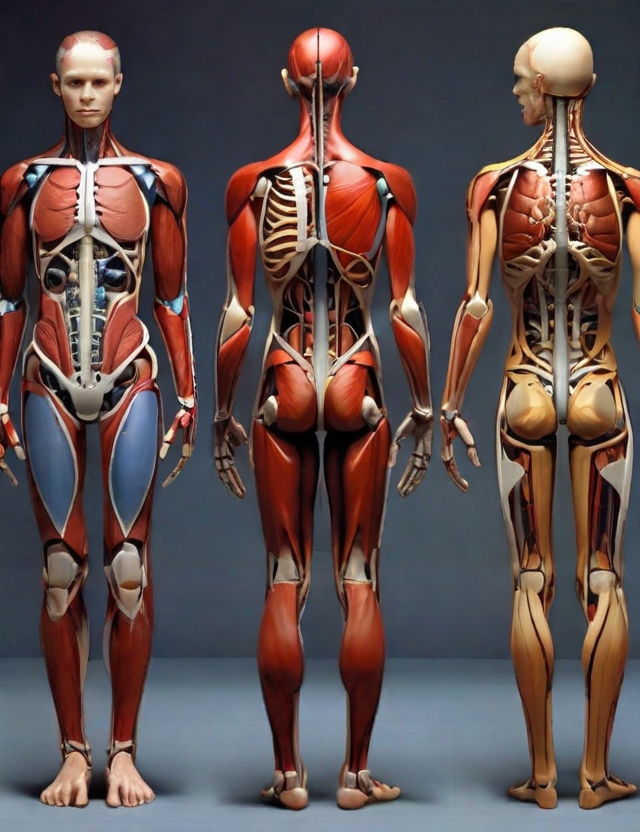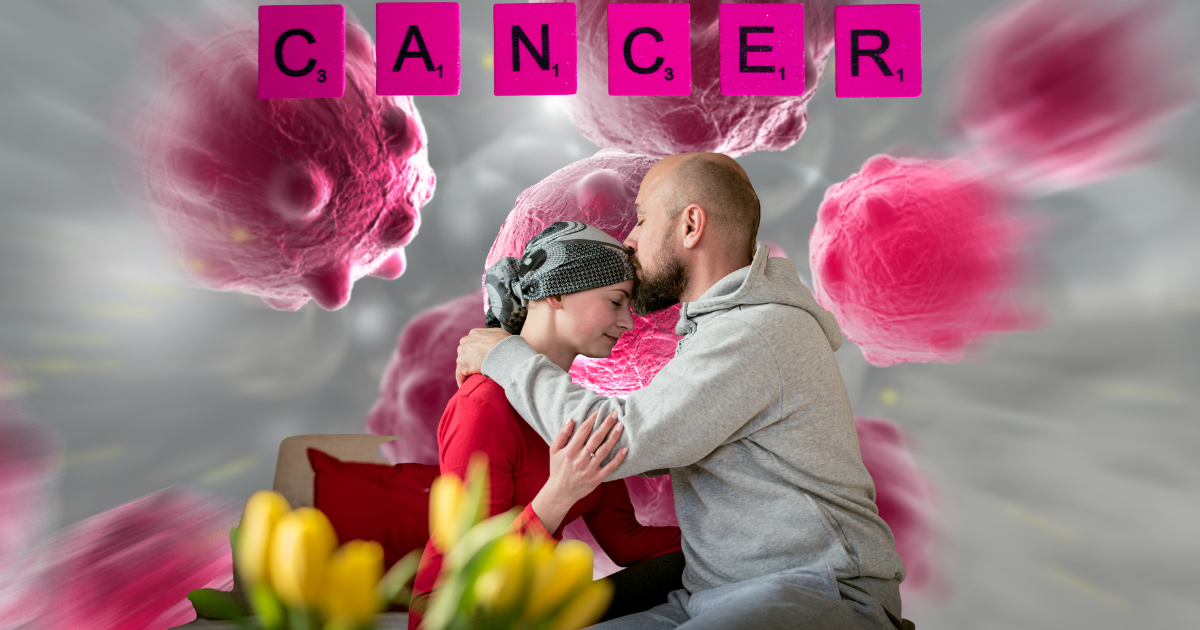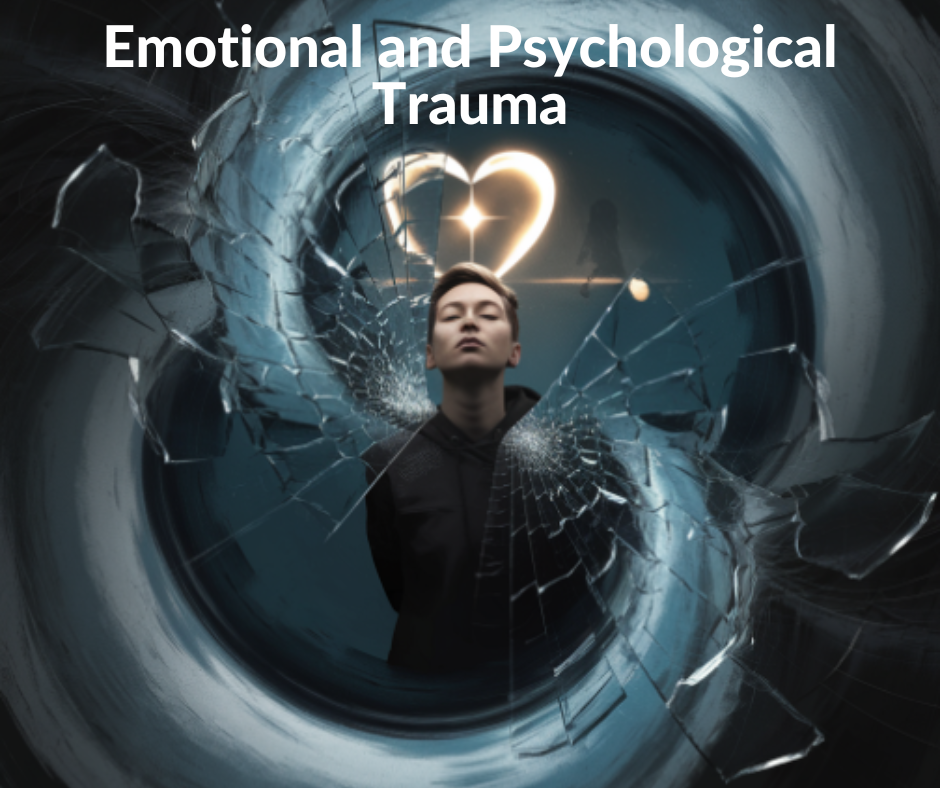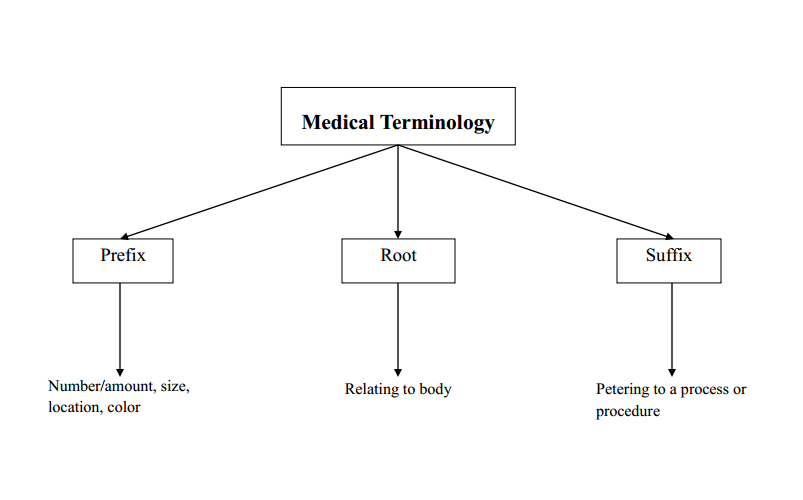
Prefixes: Size & amount
Macro – Large, visible to naked eyes
Micro – Small, not visible to naked eyes
Hyper – High, above normal, elevated
Hypo – Low, below low
Ev/normo – Normal
Pan/omni – All
A/an – Absent, lacking
Megalo – Large, larger than average
Prefixes: Numerical
Mono – single, singular/single
Di/Bi – two, double
Tri – three, triple
Quad – four, quadruple
Poly – many, a lot
Oligo – Few, several, very little
Prefixes: Speed
Trachy – Rapid, fast
Brady/brachy – slow
Epi/peri/circum – Around
Prefixes: Location
Endo/intra – inside, inner, interior
Exo/extra – outside, outer, exterior
Inter – between
Trans – across
Dia/per – through, complete
Medi(o/a) – middle
Para – near by
Juxta – next to, beside, adjacent
Prefixes: Movements
Ab – away
Ad – toward
Dis – to separate
Prefixes: Color
Chromo/chromato – color
Leuko – white
Erythro – red
Cyano – blue
Chloro – green
Melun – black
Flav – yellow
Roots:
Homeo – body
Cephalo – head
Cerv – neck
Thoraco – chest
Abdomino – abdominal
Pelvo/i – pelvic
Periton – peritoneum
Derm – skin/dermis
Neuro – nerve
Hemo – blood
Arterio/angio – arteries
Veno/vena – venous
Vasculo – vascular
Musculo – muscle
Myo/sarco – muscle
Skelet – skeleton, bone
Osteo – bone
Cyto – cell
Cyte – cell, cellular
Neck & Thoracic organs:
Thyro – thyroid
Tracheo – trachea
Esophago – esophagus
Thymo – thymus
Masto/mammo – mammary gland
Pulmo/preumo – lung
Cardio – heart
Abdominal organs:
Gasto – stomach
Hepato – liver
Cholecysto – gallbladder
Spleno – spleen
Pancreto – pancreas
Adreno – areal grand
Nephro – kidney
Entero – intestines
Colo – colon/large intestine
Suffix:
-ology – study of
-philia – love of
-phobia – fear of
-tension – pressure
-xia – oxygen
-caprea – carbon dioxide
-pnea – air
-ase – enzyme
-emesis – vomiting
-dynia/algia – pain
-itis – inflammation
-ectomy – excision, surgical removal
-lysis – separation, destruction, loosening
-pexy – fixation (of an organ)
-plasty – surgical repair
-cele – hernia, swelling
-edema – swelling
-iasis – abnormal condition
-stomy – opening, forming of
-tomy – incision
-phasia – speech
-plegia – paralysis
-rrhea – frequent discharge
-rrhexis – rupchar
-sclosis – harding
-trophy – growth
-megly – enlarge
-graphy – recording
-metry – act of measuring
-penia – decrease, deficiency
-phagia – eating, swallowing
-ectasis – dilation, expansion
-osis – abnormal condition (increase)
-emia – blood condition
-megaly – enlarge
-pathy – disease
-spasm – twitching
-genesis – forming or producing cancer
Location and Directions:
Apo – away from, separation
Acr(o) – extremity
Anter(i/o) – in front, to the front
Amb(i) – both sides
Poster(i/o) – behind, referring to behind
Dextr(o) – right, towards the right
Levo – left, towards the left
Retro – behind, backward
Alt(i) – high
Cellular Modifiers:
Ather(o) – fat
Albumin(o) – albumin (protein)
Band(o) – bands (band cells)
Amyl(o) – starch
Coccus – round
Andero – male
Gyn(o/eco) – female +
Anim – life
Calc – stone
Arachr(o) – spider
Aer(o) – air or gas
Abras(o) – to rub away
Port – to carry, mobile
Phon – sound
Cryo – cold
Auto – self
Allo – different (different human)
Xeno – different, foreign, alien
Choano – a funnel
Chord – string
Chym – juice, fluid
Cilia – hair
Cerrn – flesh
Cercin(o) – cancer, tumor
Oma – tumor
Encephalo – brain
Crypt – hidden
Dipl(o) – double
Dolich(o) – long, abnormally long
Asthenia(o) – weakness
Alter – change
Aspir(o) – inhaling, inhalation
Aspriot(o) – inhaling, inhalation
Ante – before
Pre – before
Post – after
Primi – first
Acoust(o) – to hear, hearing
Aud(i/o) – hearing
Aux – to grow or enlarge
Ben(i/e) – good
Ambul – walk, to walk
Ankyl(o) – fused, fusion, not straight
Contra – against, to counter
Crine – to secrete
Rrhage/rrhagin – heavy flow, bursting with blood Malacia – softening
Tresia – perforation, opening
Surgical Process:
Rrhaphy – suture
Clysis – irrigation, washing
Desis – surgical union, surgical fixation
Centesis – removal or fluid, aspiration
Graft – organ/tissue used for transplantation to replace
Some Medical Terms:
Myasthenia
My – muscle
Asthen – weakness
Ia – abnormal condition (Abnormal condition of muscle weakness)
Osteomalacia
Osteo – bone
Malacia – softening (Softening of bone)
Diplococcus
Diplo – double (two)
Coccus – round (shaped cell) Xenograft
Xeno – different, foreign, alien
Graft – organ/tissue used for transplantation to replace (organ/tissue from animal/human of one species transplanted to animal/human of another species)
Arthrocentesis
Arthro – joint
Centesis- aspiration Gastrorrhaphy
Gastro – stomach
Rraphy – suture
Anatomical Terms:
Head and Neck Anatomy:
Cephal(o) – head
Facio – face
Crani(o) – skull
Trich(o) – hair
Stoma/oro – mouth
Gloss(o)/linguo – tongue
Labio/cheilo – lips
Dent/odent(o) – teeth
Gingivo – gums
Rhino/naso – nose
Buccal – cheek
Geni(o)/mento – chin
Mandibulo – mandible
Sialadeno – salivary gland
Trach(o) – trachea
Laryngo – larynx
Pharyngo – throat
Thyro – thyroid gland
Epiglott(i) – epiglottis
Oto – ear
Myringo/tympano – eardrum/tympanic membrane
Cochleo – cochlea
Mastoido – mastoid process
Opto/optho/oculo – eye
Pulillo – pupil Blepharo/palpebro – eyelid Conjuctiv(o) – conjunctiva
Ophryo – eyebrow
Retin(o) – retina
Kerat(o) – cornea
Irid(o) – iris
Hyal(o) – vitreous humor of eye
Dacryoaden(o) – lachrymal/tear gland
Lacrimo – lachrymal/tear duct
Digestive system:
Celi(o)/loporo – abdomen or belly
Gastro – stomach
Pyloro – pyloric sphincter
Cholecyst – gall bladder
Choledocho – common bile duct
Chol(e/o)/billi – bile
Cholangio – bile duct
Entero – intestines
Pancreato – pancreas
Duodeno – duodenum (first section of small intestine)
Jejuno – jejum (second section of small intestine)
Ilco – illium (third section of small intestine)
Append/appendico – appendix
Ceco/typilo – cecum
Sigmoido – sigmoid colon
Ano/proct(o) – anus or rectum
Musculoskeletal System:
Condyl – condyles
Condro – cartilage
Om(o) – shoulder
Acromio – acromion of scapula
Axillo – axilla (arm pit)
Brachio – arm
Gleno – glenoid cavity/fossa
Olecrano – elbow (olecranon)
Cubito – elbow/forearm
Spino/rachi(o) – spine
Myelo – spinal card/bone marrow
Spondylo – vertebrae
Sterno – sternum
Clecid(o)/clavicalo – clavicle
Cost(o) – ribs
Cox(o) – hip
Acetabulo – acetabulum
Ischi(o) – ischium
Ili(o) – ilium
Pubo – pubis
Sacro – sacrum
Coccy/coccyg/coccygo – coccyx
Crur – leg
Femor(o) – femur
Chir(o)/cheiro – hand
Onych(o) – nail(s)
Phalang(o)/dact(i/o) – phalanges/digits
Corp(o) – wrist
Metacarp – metacarpals
Podo – foot
Tars(o) – ankle
Metatars – metatarsals
Calcanio – cancanus bone
Female reproductive anatomy:
Salpingo – fallopian tubes/oviducts
Ovary(o)/oophori – ovary
Ovo/ovi/oo – egg/ovum
Episi(o) – vulva
Colpo/vagin(o) – vagina
Cervic(o) – cervix of uterus
Hyster(o)/meterio – uterus
Hymeno – hymen
Male reproductive anatomy:
Sperm(o)/spermato – sperm
Orchi(o)/orchido – testicles
Oscheo – scrotum
Epididym(o) – epididymis
Prost – prostate
Balan(o)/phallo – penis
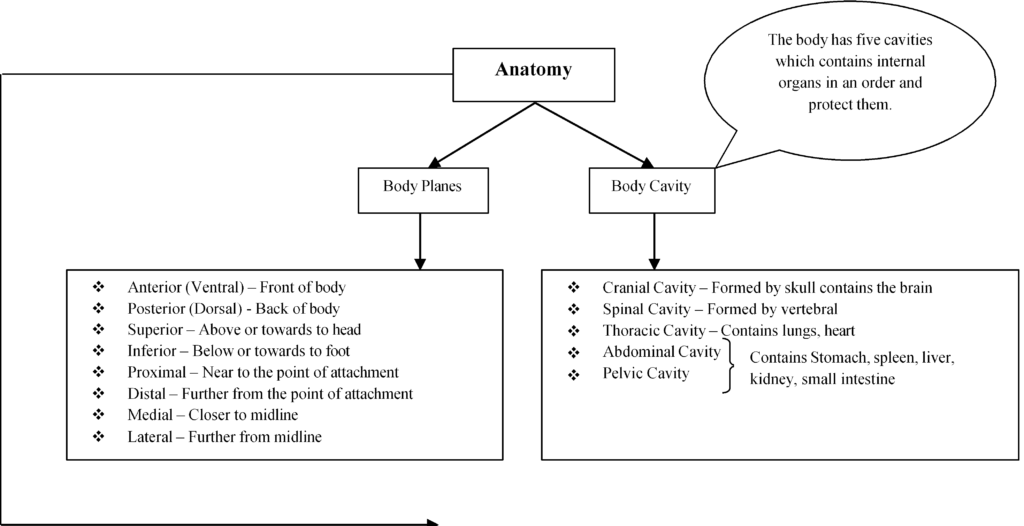

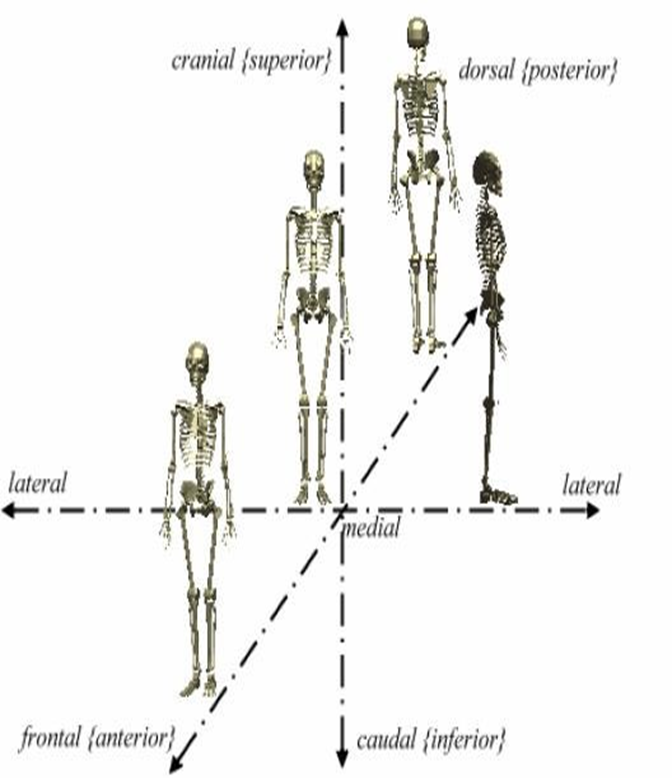
Organ System
Musculoskeletal System:
Functions:
Production of vital/internal organ
Movement & stability of body
Production of red blood cells in bone marrow
Temperature regulations
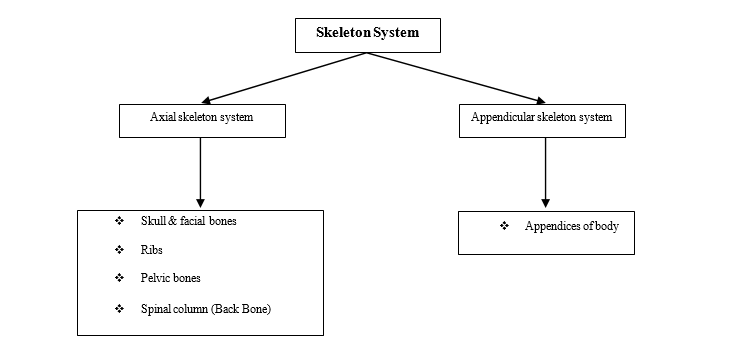
Skeleton System:
Axial bone name:
It consists 80 bones:
29 bones in head (8 cranial and 14 facial bone) and then 7 associated bones (6 auditory ossicles and the hyoid bone)
25 bones of the thorax (the sternum and 24 ribs)
26 bones in vertebral column (24 vertebrae, the sacrum and the coccyx)
Appendicular bone name:
4 bones in the shoulder girdle (clavicle & scapula each side)
6 bones in the arm and forearm (humorous, ulna and radius)
58 bones in the hands (carpals 16, metacarpals 10, phalanges 28 and sea-maid 4)
2 pelvis bone
8 bones in the legs (femur, tibia, patella and fibula)
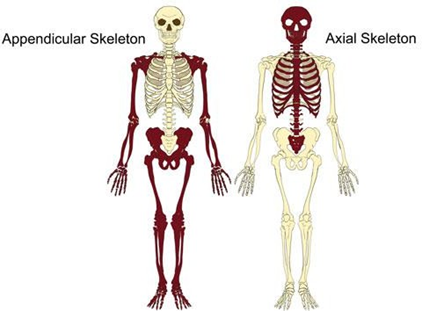
Tendons: These attach muscle to bone (MTB). Ligaments: These attach bone to bone (BLB). Cartilage: These attach muscle to muscle (MCM).
Skull Bone:

Facial Bone:

Ribs (Bones of Chest):

Pelvis Bones:

Spinal Column (Back Bone) [Vertebra]:
| a. Cervical | – | 7 |
| b. Thoracic | – | 12 |
| c. Lumber | – | 5 |
| d. Sacrum | – | 5 |
| e. Coccyx | – | 1 |
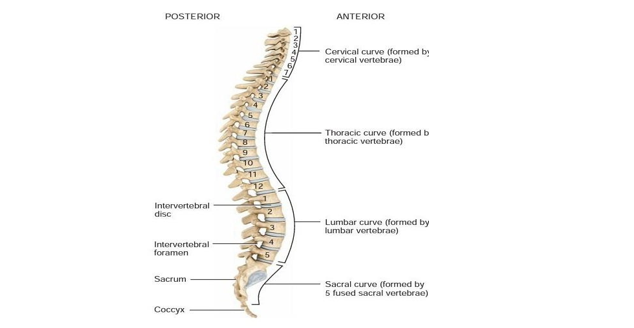
Shoulder:
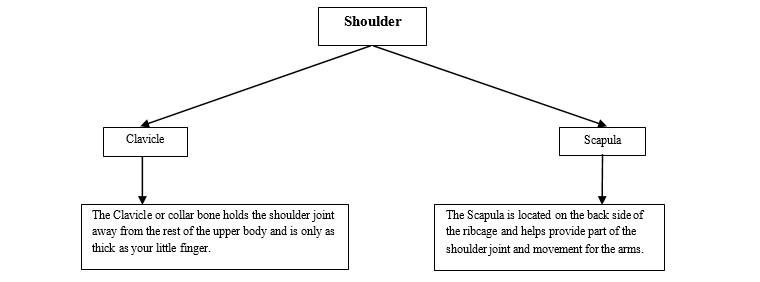
Bone of upper extremity:


Bone of lower extremity:

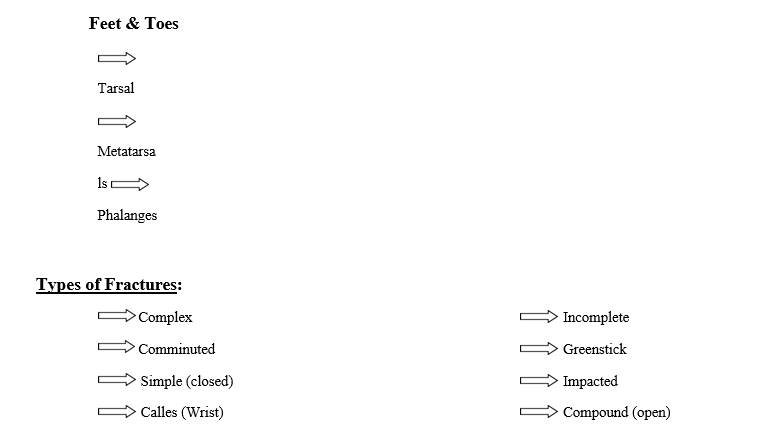
Sinus:
Disease of bone:
Rickets: Bone softening disease that causes severe bioury of less, poor growth and sane toms muscle growth and weakness. (Vitamin B)
Osteoporosis: Bone tissue becomes brittle, thin and spongy.
Ankylosis: Condition of stiffing of joint.
Arthralgia: Joint pain
Arthratis: Inflammation in joint
Arthophathy: Disease in joint
Joints:
There are three types of joints.

Plane Joint: A plane joint (arthrodial joint, gliding joint, plane articulation) is a synovial joint which, under physiological conditions, allows only gliding movement.
Saddle Joint: A saddle joint is a synovial joint where one of the bones forming the joint is shaped like a saddle with the other bone resting on it like a rider on a horse. Saddle joints provide stability to the bones while providing more flexibility than a hinge or gliding joint.
Hinge Joint: A hinge joint is a common class of synovial joint that includes the ankle, elbow, and knee joints. Hinge joints are formed between two or more bones where the bones can only move along one axis to flex or extend.
Pivot Joint: In animal anatomy, a pivot joint (trochoid joint, rotary joint, lateral ginglymus) is a type of synovial joint. In pivot joints, the axis of a convex particular surface is parallel with the longitudinal axis of the bone.
Ball-and-Socket Joint: A natural or manufactured joint or coupling, such as the hip joint, in which a partially spherical end lies in a socket, allowing multidirectional movement and rotation.
Ellipsoid Joint: A condyloid joint (also called condylar, ellipsoidal, or bicondylar) is an ovoid particular surface or condyle that is received into an elliptical cavity. This permits movement in two planes, allowing flexion, extension, adduction, abduction and circumduction.
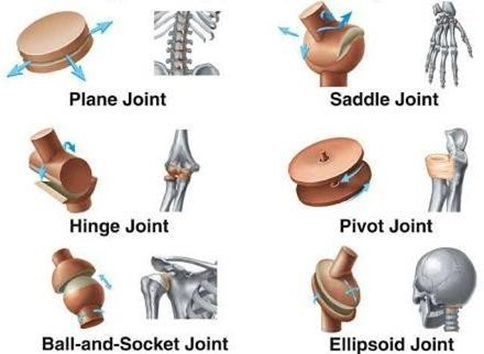
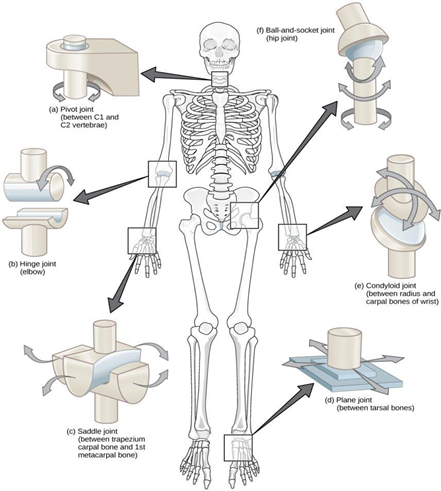
Muscles:
Muscles are male up of cells and connective tissues. Muscles contracts, provide and produce heat for the body. There are three types of muscles:
Skeletal Muscle: These are also called striated muscle. Skeletal muscles are attached to the skeleton bone by tendons.
Cardiac Muscle: These are also called heart muscle. They help our heart in contraction.
Smooth Muscle: These are found in walls of all the hollow organs of the body except the heart. Its contraction reduces the size of these structures of movement.
Integumentary System:
Integumen: Skin, Derm, Cutane
The integumentary system comprises the skin and its appendages acting to protect the body from various kinds of damage, such as loss of water or damages from outside.
It is the largest organ system in the body. It includes skin, hair and nails. These structures work together and provide:
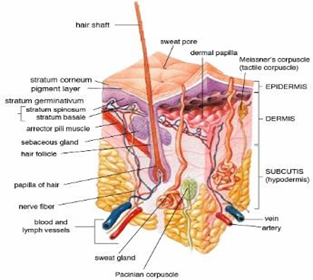
Protection of injury
Fluid loss
Protect from microorganism (bacteria, virus, fungus)
Temperature regulations
Sensations
Skin: Two layers of skin: Dermis, Apidermis
Apidermis Skin: Apidermis provides external coverage of human body.
Dermis: Dermis is located just under Apidermis. Dermis contains important structure that nourish and innerwight the skin.
Blood vessels
Nerves
Glands
Hair follicles
Medical terms related to Skin: Qutenius, Dermatology, Decubitus (pressure alsure), Ecchymossis (in condition in which blood color changes in to the skin), Hypoderonic, Jaundice, Melonil, Melanuma (pigmented tumor of skin), Tinea (fungal infection of skin).
Disease of hair or nails: Alopecia (loss of hair), Lunula (little man area of nail), Nail bed (skin below the nail or bid matrix), Onychitis (inflammation of nail matrix).
Cardiovascular System:
The cardiovascular system is a series of tubes (blood vessels) filled with blood connected to a pump (heart).
Blood Vessels:
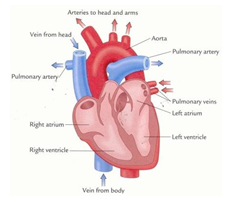
Arteries: Carry oxygenated blood from the heart.
Veins: Veins carry deoxygenated blood from body to heart.
Capillaries: Capillaries are timey vessels. They are semi-permeable and facilitate the exchange of fluid, oxygen, nutrias and waste material between tissues and blood stream.
The heart is composed of three layers:
Epi Cardium (Outer layer)Myo Cardium (Muscle of the heart)
Endo Cardium (Inter lining of heart)
The heart is enclosed in a double wall lining called as pericardium membrane.
The lungs receive deoxygenated blood from the right ventricle via pulmonary artery.
The oxygenated blood is circulated through the lungs and sends back in the left atrium of the heart through the pulmonary vein.
Oxygenated blood is pumped from the left side of the heart that is left ventricle to the aorta. Aorta is responsible for pumping the blood throughout the entire body.
Heart Valves:
Tricuspid Valve: It present in between right atrium and right ventricle which prevent back flow of blood from right ventricle to right atrium.
Pulmonic Valve: It present in between pulmonary artery and right ventricle prevent back flow of blood from pulmonary artery to right ventricle.
Mitral (Bicuspid) Valve: It present in between left atrium and left ventricle which prevent back flow of blood from left ventricle to left atrium.
Aortic Valve: It present in between left ventricle and aorta which prevent back flow of blood from left ventricle to aorta.
Medical terms related to cardiovascular system: Angiocarditis (inflammation of heart and vessel), Arteriosclerosis (haring of artery) and Atherosclerosis (narrowing of vessel lumen due to plaque/fat formation on inside of walls).
Causes: Diet high in fat, cholesterol, salt, inactive lifestyle, smoking
Risks: High BP, enlarged heard, embolus blocking circulation, stoke.
Coronary Artery Disease: Artery who supply blood to heart muscle known as coronary artery when atherosclerosis affects the arteries that supply the heart muscle.
Symptoms: Short of breath after simple exertion, angina (chest pain)
Risk: MI (Myocarid Infection), cardiac assest, death.
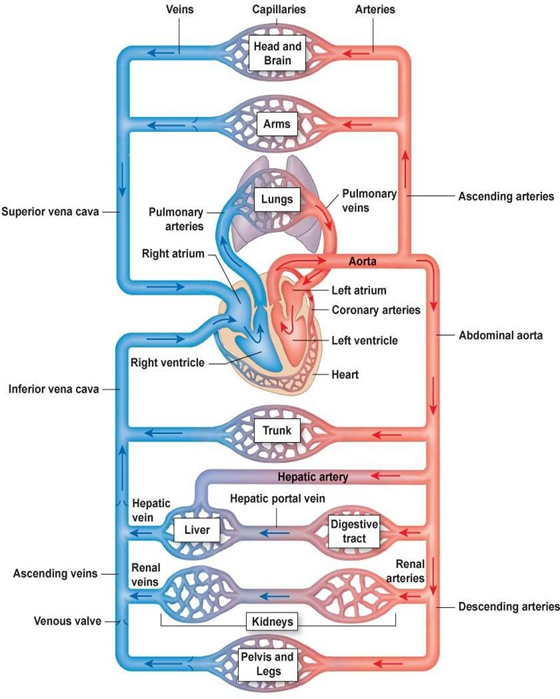
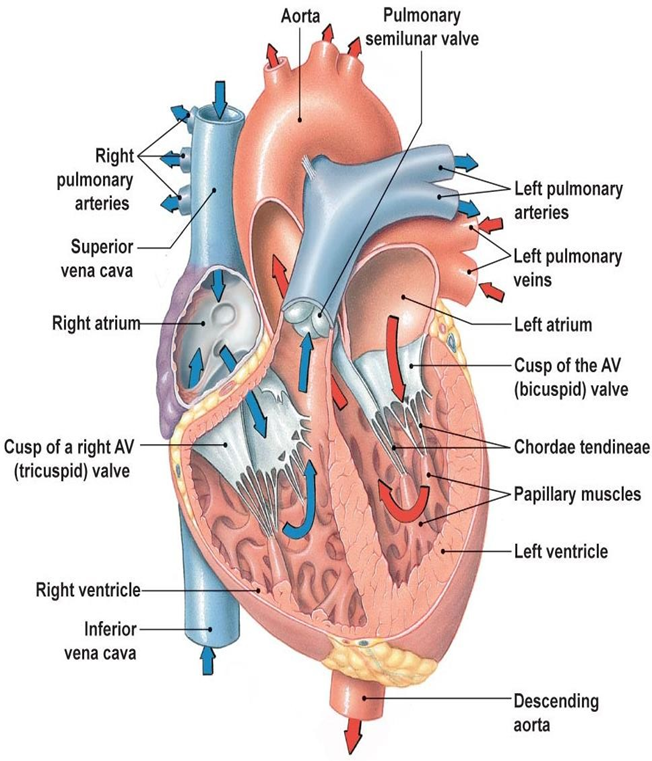
Cardiac Conduction System
The Cardiac conduction system is a group of specialized cardiac muscle cells in the walls of the heart that send signals to the heart muscle causing it to contract. The main components of the cardiac conduction system are the Sinoatrial (SA) node, Atrioventricular (AV) node, Bundle of His, Bundle branches and Purkinje fibers.
Sinoatrial (SA) node: The SA node is the heart’s natural pacemaker. The SA node consists of a cluster of cells that are situated in the upper part of the wall of the right atrium (the right upper chamber of the heart). The electrical impulses are generated there. The SA node is also called the sinus node.
Atrioventricular (AV) node: The electrical relay station between the upper and lower chambers of the heart. Electrical signals from the atria must pass through the AV node to reach the ventricles. The AV node, which controls the heart rate, is one of the major elements in the cardiac conduction system.
Bundle of His: The Bundle of His is an important part of the electrical conduction system of the heart, as it transmits impulses from the Atrioventricular node, located at the inferior end of the interatrial septum, to the ventricles of the heart.
Bundle branches: The Bundle branches or Tawara branches are offshoots of the bundle of His in the heart’s ventricle. They play an integral role in the electrical conduction system of the heart by transmitting cardiac action potentials from the bundle of His to the Purkinje fibers.
Purkinje fibers: During the ventricular contraction portion of the cardiac cycle, the Purkinje fibers carry the contraction impulse from both the left and right bundle branch to the myocardium of the ventricles.
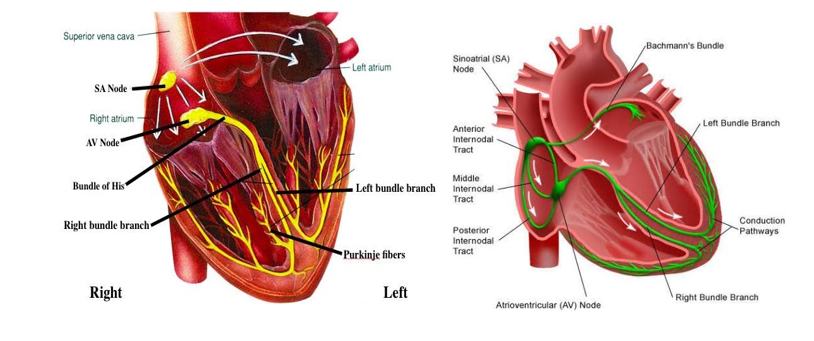
Physiology of cardiac conduction system:
The Cardiac conduction system is designed for electrical impulse creation and propagation. It allows for initiation of impulses in the atrium, slowed conduction in the Atrioventricular (AV) node and rapid propagation through the His- Purkinje system to allow synchronous contraction in the ventricles.
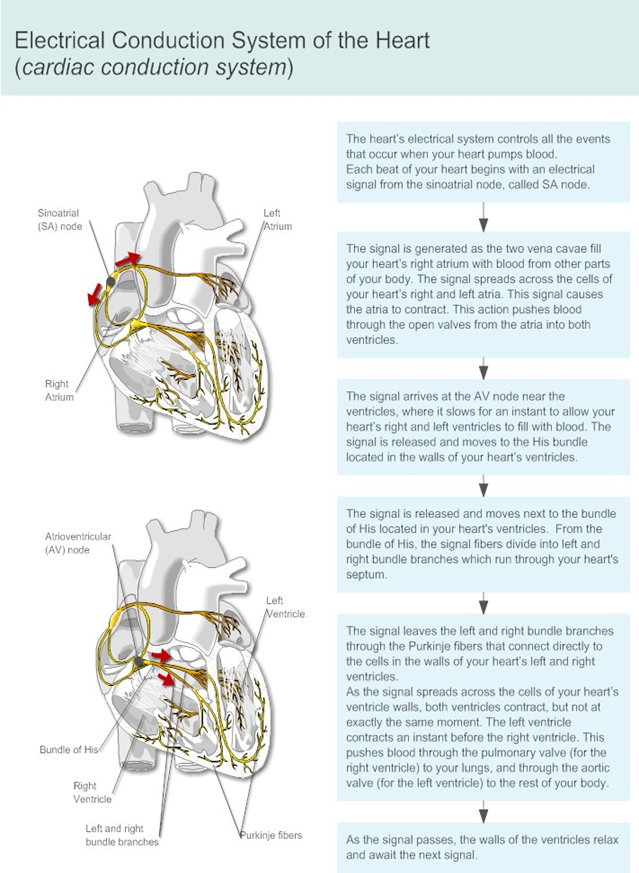
Lymphatic System:
Lymphatic system composed of lymph vassals or nodes.
The lymphatic organs include spleen, thymus, tonsils and peyer’s paches of the intestines.
Lymphatic system removes access fluid from the body and provides defense system & resistance to disease.
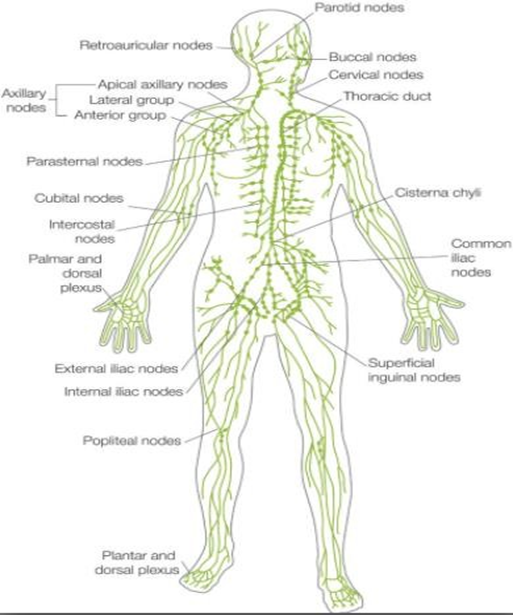
Lymph is a colorless fluid that is composed of white blood cells like lymphocytes which are the cells that attack bacteria in the blood, and other white blood cells that help the body get rid of toxins, waste, and any other unwanted cells. Lymph is created after plasma delivers nutrients and removes waste from cells from all organs and tissues. Most of the fluid that carries this goes back into the blood system, but what is left behind to keep transporting the rest is lymph. Lymph travels through the lymph vessels, which are very similar to our blood veins, towards the heart to be filtered. Lymph is filtered from foreign cells such as bacteria and cancer cells at the lymph nodes which are located in clusters in various parts of the body, such as the neck, armpit, groin, and inside the center of the chest and abdomen. The lymph nodes are also responsible for creating immune cells to fight infection. If an infection is present in the body, the lymph nodes become swollen because of the increase of immune cells they create. There are more than 600 lymph nodes in your body. The thymus is located right above your heart and it is responsible for storing and preparing lymphocytes and sending them into the lymphatic vessels. The spleen is the largest organ part of the lymphatic system, and it is responsible for creating white blood cells, although you can live without a spleen, it makes you more vulnerable against infections. So basically the lymphatic system is a highway for lymph to deliver nutrients and disease fighting cells where they are needed while removing the toxins and foreign material from the organs and tissue.
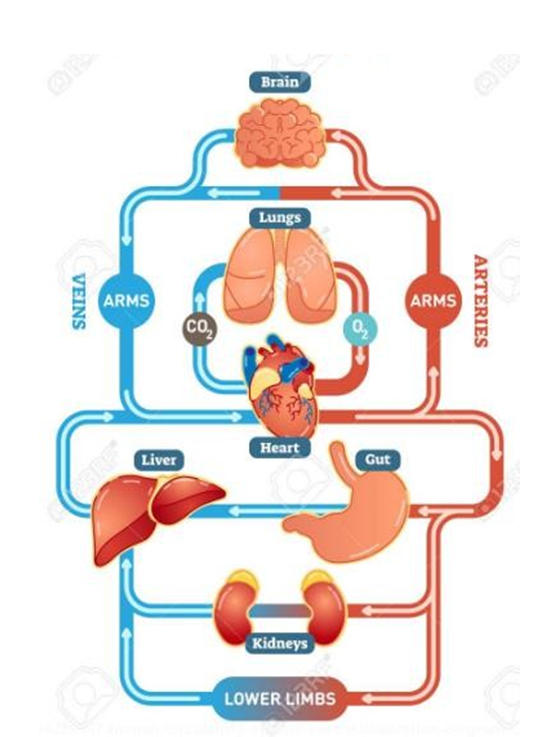
The lymphatic system is in charge of sending lots of disease fighting cells to keep you healthy but in some occasions the lymphatic system can transport diseased cells to other parts of your body such as cancer cells. Cancer can appear in the lymph nodes in two ways: it can either start there (Lymphoma) or it can spread there from somewhere else. Most of the times if a cancer cell manages to separate from a tumor and enter a lymph vessel, the white blood cells attack and kill it. When the cancer cell travels without being destroyed it can attach itself to an organ or tissue and start growing, thus metastasizes the cancer. If the cancer cells stay in the lymph vessels and infect the lymph nodes or there is cancer too close to the lymph nodes, they may need to be surgically removed causing Lymph edema which is a chronic swelling of the limbs caused by the accumulation of lymph fluid due to lack of lymph nodes. The lymphatic system is an important part of our body since it is mainly responsible for cleaning our body and fighting diseases. If you notice swollen lymph nodes in the areas where they are most present such as the neck, armpit, and groin consult with your physician immediately. There are treatments that may be used to compliment your immune system and help fight diseases through the lymphatic system.
Respiratory System:
The respiratory system is a biological system consisting of specific organs and structures used for gas exchange in animals and plants. The anatomy and physiology that make this happen varies greatly, depending on the size of the organism, the environment in which it lives and its evolutionary history.
Nostrils -> Nasal passage -> Pharynx -> Larynx/sound box -> wind pipe/trachea -> lungs -> Bronchus (Bronchi) -> Bronchiole (Bronchioles) -> Alveolus (Alveoli) -> Pleura -> Diaphragm
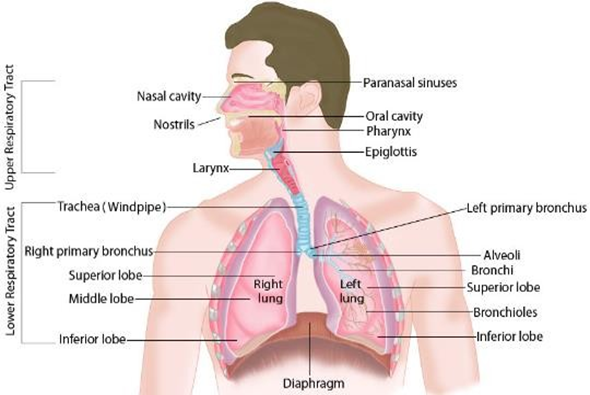
Pleura is a thin membrane covering both the lungs.
Wheezing: Weaseling sound coming during respiration caused by air passages obstructions.
Digestive System:
Mouth: Teeth, salivary glands (parotid, sub maxillary, sublingual).
Functions: Mechanical breakdown of food.
Types of Teeth:

Esophagus:
10 inches long which connects mouth with the stomach.
Peristalsis: Propels food and liquids slowly down the oesophagus into the stomach.
Stomach:
J shaped muscular sac
Food is mixed with gastric juices (HCL & Enzymes) secreted by the stomach wall.
HCL helps to breakdown of food and kills bacteria that come along with food.
Enzymes

Small Intestine:
Long 20 ft, coiled tube beneath the stomach. It has three parts:
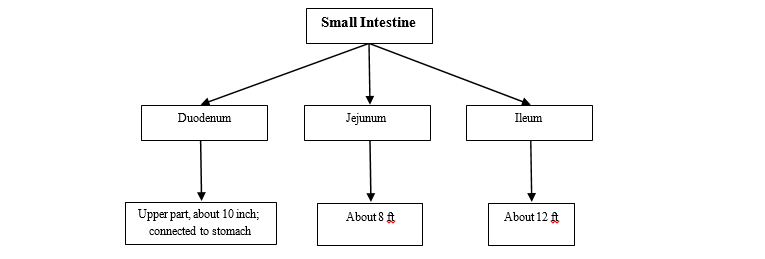
Ville and microvilli increases the surface area of small intestine for greater absorption. Peristalsis moves the undigested food to large intestine.
Functions: Mixing, secretion, digestion, absorption, elimination.
Large Intestine:
Larger diameter but shorter in length (5 ft).
Water is observed from undigested food making the waste harder until it become solid.
Waste stays for 10 to 12 hours.
Appendix hangs on the right side of the large intestine. This is further divided into: Colon and Rectum.
Accessory Part:
Liver: Largest gland of the body.
Physiology of Liver:
Secretes bile to gall bladder via hepatic duct and cystic duct.
Stores vitamin A, D, E, K, sugar and glycogen.
Formation of urea.
Destruction of RBC forming bile pigment and iron.
Maintenance of body temp.
Excretion of toxic substances.
Gall bladder:
Measures approximately 8 cm in length and 4 cm in diameter.
Stores bile in-between meals.
Secretes bile to the duodenum through the bile duct during mealtime.
Pancreas:
Produces a juice that contains enzymes (amylase, insulin, trypsin and chymotrypsin) to breakdown carbohydrates, fat and proteins.
Secretes the juice in pan creative duct.
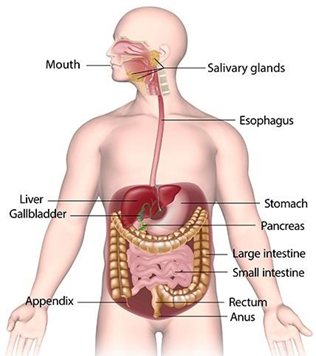
Disorder of Digestive system:
Crohn’s disease, Gastritis, Gastralgia, Dyspepsia, Gallstone, Hemorrhage from stomach, Peptic ulcer disease, Cancer of stomach, Hyperscretion and hyperacidity, Dilatation of stomach, Peristaltic unrest.
Excretory (Urinary) System:
The excretory system is the system of an organism’s body that performs the function of excretion, the bodily process of discharging wastes. The Excretory system is responsible for the elimination of wastes produced by homeostasis.
Kidney seems like bean. The Excretory system contains:
Paired kidney.
A ureter for each kidney
Urinary bladder
Urethra
Functions:
Kidney filters blood to keep it pure.
Toxins
Metabolic wastes
Excess water
Excessions
Dispose of nitrogenous wastes from blood.
Urea
Uric acid
Creatinine
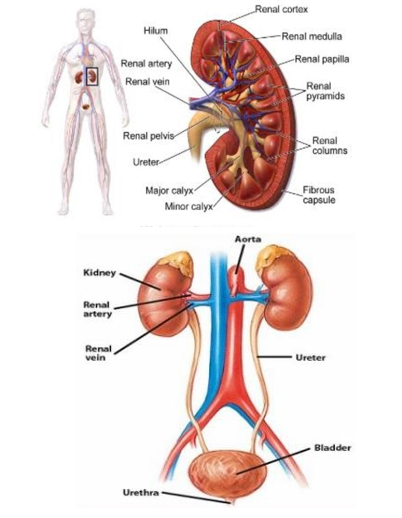
Regulate the balance of water and electrolytes, acids & bases.
The four functions of the excretory system are to get rid of wastes, eliminate useless byproducts excreted from cells, eradicate harmful chemical buildups and maintain a steady, balanced chemical concentration in the body.
Kidney has two regains: Cortex (outer) and Medulla (inner).
Medical terms related to Urinary System: Dysuria (Difficulty in urine), Hematuria (Blood in urine), Nephritis (Inflammation in kidney), Nephropathy (Disease of kidney), Polyuria (Execution urination), Cytoplasty ( Repair of bladder), Incontinence (Inability to hold urine).
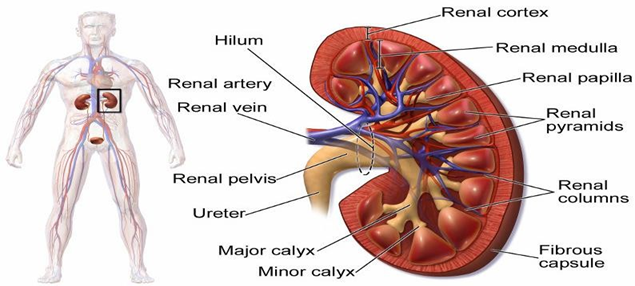
Reproductive System:
The reproductive system or genital system is a system of sex organs within an organism which work together for the purpose of sexual reproduction. Many non-living substances such as fluids, hormones, and pheromones are also important accessories to the reproductive system.
The male and female reproduction organs include external and internal genitalia.
Male Genitalia:
External organ of male genitalia:
Testes
Scrotum
Epididymis
Penis
Internal organ of male genitalia:
Prostate glands
Seminal vesicles
Cowper glands

Female Genitalia:
External organ of female genitalia:
Vulva
Labia majora & labia minora
External opening of vagina

Internal organ of female genitalia:
Uterus
Fallopian tubes
Ovaries
Medical terms related to Urinary System: Amenorrhea (Absence of menstruation), Antepartum (Time period during pregnancy before delivery), Dysmenorrheal (Painful menstruation), Hysterotomy (Surgical incision in uterus), Hysterectomy (Surgical removal in uterus), Mastectomy (Surgical excretion of phylipion tubes), Virginities (Inflammation in vagina).
Endocrine System:
The endocrine system is the collection of glands that produce hormones that regulate metabolism, growth and development, tissue function, sexual function, reproduction, sleep and mood, among other things.
The endocrine system is made of glands and secretes hormones. Hormone has a unique effect on our body/organs.
Glands:

Pituitary Gland (Brain): Hormones:
Oxytocin (Contraction of Uterus, Secretion of milk)
TSH (Thyroid stimulating hormone)
FSH (Follicle stimulating hormone)
LH (Luteinizing hormone)
GH (Growth hormone)
Thyroid Gland (Neck):
It regulates metabolism
Regulate calcium level
Adrenal Gland (Kidney): Hormones:
Epinephrine
Non epinephrine

Nervous System:
The nervous system is the part of an animal that coordinates its actions by transmitting signals to and from different parts of its body. The nervous system detects environmental changes that impact the body, and then works in tandem with the endocrine system to respond to such events.
Nervous Tissue: The majority of the nervous system is tissue made up of two classes of cells: neurons and neuralgia.
Neurons: Neurons, also known as nerve cells, communicate within the body by transmitting electrochemical signals. Neurons look quite different from other cells in the body due to the many long cellular processes that extend from their central cell body. The cell body is the roughly round part of a neuron that contains the nucleus, mitochondria, and most of the cellular organelles. Small tree-like structures called dendrites extend from the cell body to pick up stimuli from the environment, other neurons, or sensory receptor cells. Long transmitting processes called axons extend from the cell body to send signals onward to other neurons or effectors cells in the body.
There are 3 basic classes of neurons: afferent neurons, efferent neurons and inter neurons.
Afferent neurons: Also known as sensory neurons, afferent neurons transmit sensory signals to the central nervous system from receptors in the body.
Efferent neurons: Also known as motor neurons, efferent neurons transmit signals from the central nervous system to effectors in the body such as muscles and glands.
Inter neurons: Inter neurons form complex networks within the central nervous system to integrate the information received from afferent neurons and to direct the function of the body through efferent neurons.
Neuralgia: Neuralgia, also known as glial cells, acts as the “helper” cells of the nervous system. Each neuron in the body is surrounded by anywhere from 6 to 60 neuralgia that protect, feed, and insulate the neuron. Because neurons are extremely specialized cells that are essential to body function and almost never reproduce, neuralgia are vital to maintaining a functional nervous system.
Nervous system divided into two parts:
Central nervous system (CNS)
Brain
Spinal Card
Peripheral nervous system (PNS)
Brain: It has four parts:
Cerebrum Functions: Sense, Language, Memory and Emotions.
Cerebellum Functions: Maintain equilibrium and balance of body.
Diencephalon Functions: Regulate heart beat, body temperature and fluid balance.
Brain Stem Functions: Controls respiration, blood pressure and heart rate.
Spinal Card:
1. It transmits sensory impulses from the body to brain.
2. It controls motor impulses from the brain to the organ of the body.



Disease of Nervous system:
Radiculopathy/Radiculitis: Inflammation of nerve root
Cerebrovascular disease or accident [CVA]: disorder of blood vessels of the brain. Commonly called as stroke.
Seizure disorder: also called as Epilepsy. It’s caused by brain injury or any birth disaffects, brain tumor, hormonal imbalance
Parkinson disease: also called as Palsy. Unnatural shaking of head, decrease speed of movement
Alzheimer disease: It’s a disorder that causes memory loss and serious mental condition. Initial stage of this disease is called as Dementia.
Anxiety disease: feeling of wrong, lacking of energy and loss of interest in life
ADHD: Attention Deficit Hypersensitivity Disorder
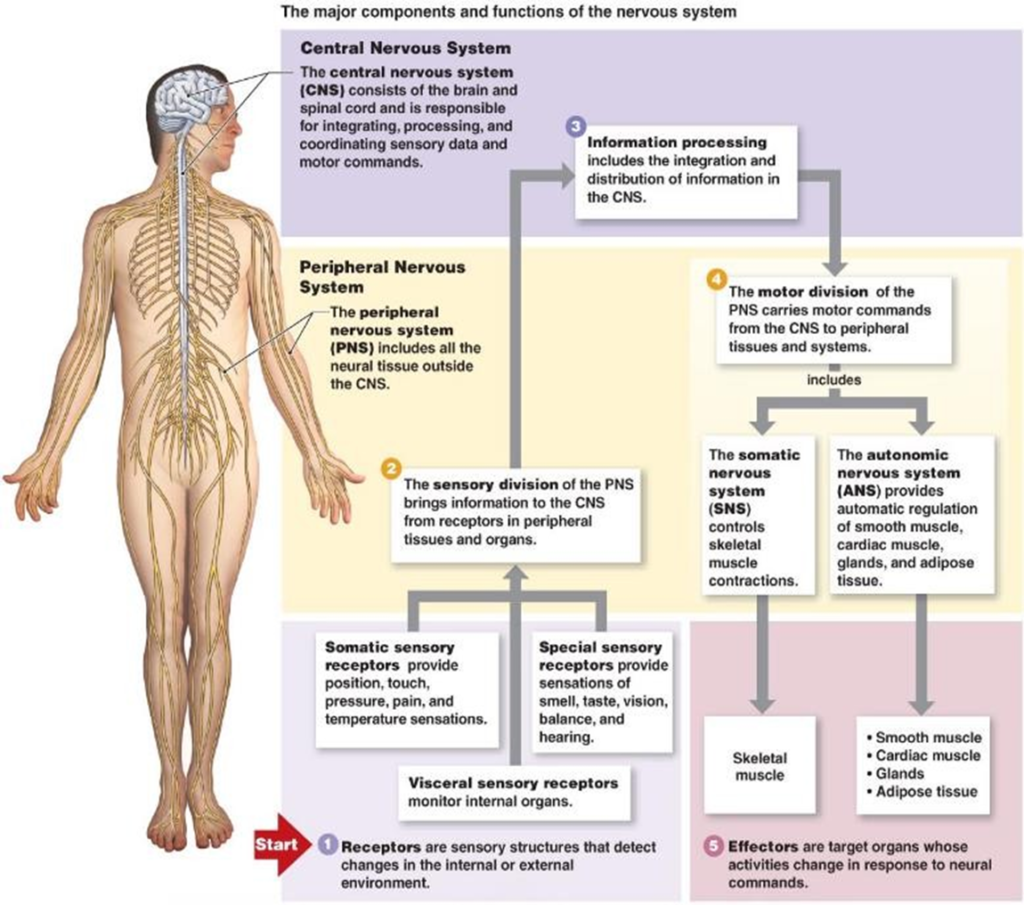
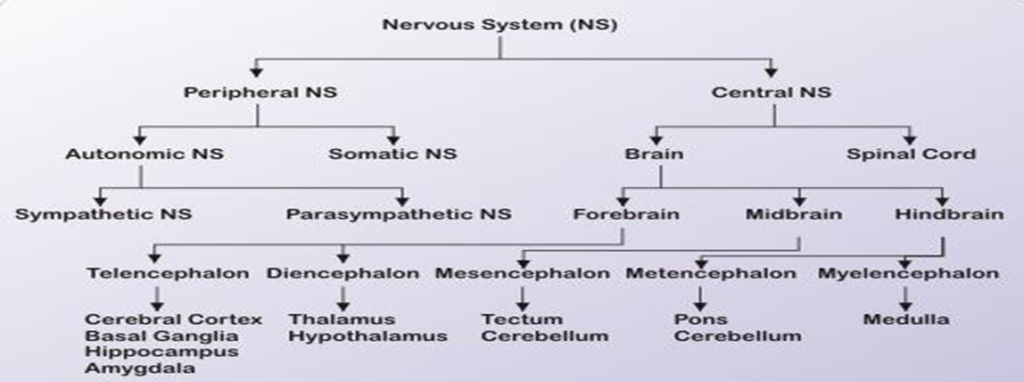
20 Names of Body Parts and Elements and Their Figurative Meanings:
- Arm: something resembling an arm in form and/or function, a part of a garment covering the arm, might or power or ability, a component or division or support.
- Blood: refers to kinship or lineage, or to a quality intrinsic to someone because it’s supposedly a hereditary trait, or to bloodshed; as a verb, refers to providing a hound with a scented object to prompt a hunt, or to introducing to bloodshed or killing.
- Bone: the core, essence, or heart of something, or the design or framework of a composition, or a subject (usually in the idiom “bone of contention”) or an inclination or talent or, more often, the lack thereof (“I don’t have an artistic bone in my body”), or something intended to placate (“Throw him a bone”).
- Breast: the location of emotion, something resembling a breast, or part of a garment that covers the literal breast (the sometimes-synonym chest first referred to a box and then was applied, by association, to the section of the body).
- Foot: something resembling a foot in form and/or function, a lower or opposite end or edge or the bottom of something, a standard length, a unit of meter in verse, or a step or speed.
- Heart: courage or fortitude or persistence, affection or compassion or feelings, the center or essential or vital part of something, or a stylized representation of the organ, or one or more playing cards featuring such a symbol or a card game focusing on this suit.
- Hip: an angle of an intersection of parts of a roof.
- Intestine: the phrase “intestinal fortitude,” describing courage, derives from the association of the intestines with bravery (compare the informal synonym guts).
- Leg: a limb like component, the part of an article of clothing or footwear that covers the leg, part of a journey or race, or one competition among several similar events or long-term appeal or interest.
- Liver: a grayish and reddish brown and seen in the expression “lily livered,” meaning “cowardly”.
- Lungs: a respiratory aid or device, or a variation of the literal meaning referring to someone’s capacity for producing loud sounds.
- Muscle: physical force especially for intimidation or persuasion; as a verb, to infiltrate (often in the phrase “muscle in”).
- Neck: a geographical or structural feature resembling a neck, or a narrow margin (as in the finish of a race), or, informally, a part or region; as a verb, to narrow or to caress and kiss passionately.
- Shoulder: the side of an artificial or natural structure, as the shoulder of a road or of a mountain; as a verb, to push aside, or to bear as with responsibility.
- Stomach: courage or fortitude, or desire or inclination, or appetite; in verb form, to put up with or withstand.
- Torso: an artistic representation of the human trunk or something incomplete or damaged.
- Vein: a channel of water or a bed of mineral in rock or ice, or a quality or style or an aptitude or mood.
18: Viscera: in the adjectival form, visceral, corresponds to the adjective gut (for example, “gut feeling”), meaning “instinctive” (as in “She had a visceral sense that she was in danger”); alternatively, it means “earthy” (“The movie has a visceral tone with its coarse characters and rough action”).
–Waist: something resembling a waist in form and/or function (as part of an aircraft or marine vessel), an article (or part of an article) of clothing worn on or around the waist or a line around the waist or a measurement of the line.
–Womb: a space resembling a womb in form and/or function, or the literal or figurative birthplace of an idea, product or other physical or intellectual creation.
